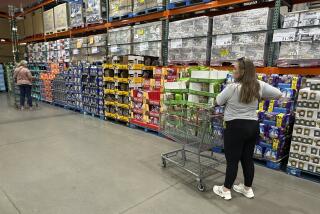Consumer Borrowing Surges Past Expectations in July : Economy: Credit grew by $8.8 billion. Rising wholesalers’ inventories and declining sales also reported.
- Share via
WASHINGTON — U.S. consumers stepped up their borrowing in July, as credit card use posted the largest increase in almost three years, Federal Reserve figures showed Wednesday.
Consumer credit grew by a larger-than-expected $8.8 billion to $1.354 trillion in July after rising by $3.3 billion the month before, the Fed said. Analysts had expected borrowing to grow by $6 billion in July.
Other data Wednesday from the Commerce Department showed inventories at U.S. wholesalers rose 0.9% in July, their fastest pace in 10 months. Sales fell 0.2%, the first decline since January.
Analysts are expecting companies to replenish stockpiles in the second half and build a cushion against any supply disruptions associated with the arrival of Jan. 1, 2000.
July’s surge in borrowing would translate into an annual growth rate of 7.9% in consumer debt, compared with a 2.9% pace in June. Borrowing rose 5.4% for all last year.
“As long as the labor market remains strong and inflation stays low, we see no obvious reason for the consumer to cut back on spending,” said Cynthia Latta, an economist at Standard & Poor’s DRI in Lexington, Mass.
Consumer spending has been pushing the U.S. economic expansion, now in its ninth year and just five months away from becoming the longest ever. The Fed has raised the benchmark interest rate from 4.75% to 5.25% in two steps starting June 30, in an effort to keep growth from driving up inflation.
Fed Chairman Alan Greenspan, in a speech in Grand Rapids, Mich., suggested that productivity advances through information technology should enable the expansion to continue. Those advances have “begun to alter, fundamentally, the manner in which we do business and create economic value,” Greenspan said, repeating a favorite theme.
Greenspan, whose previous public comments Aug. 27 raised fresh concerns about the increasingly powerful role of the stock market in the U.S. economy, didn’t revisit the subject Wednesday.
Investors and economists watch the Fed’s report on credit to help them gauge consumer demand.
Revolving loans, which include credit cards, rose $5.9 billion in July--the biggest increase since November 1996--after increasing $5.5 billion in June. Auto and other loans rose $3.1 billion after falling $2.3 billion.
Still, the report gives an incomplete picture because it fails to account for lower-interest home equity loans and other lending secured by real estate. Also, the monthly numbers are often volatile.
With unemployment tying a 29-year low of 4.2% in August, the outlook for retailers is bright. Consumer optimism and quicker debt repayment by credit card shoppers should help keep sales buoyant through the holidays, analysts said.
Still, the good times have no guarantee of continuing, Treasury Secretary Lawrence Summers said in a speech to the New York Economic Club. He called on the government to take steps to reduce risk in financial markets and increase support for poor families and communities.
“Complacency can itself be a threat to good times if it leads to excessive borrowing or lending, unsustainable spending plans, or a failure on the part of consumers, businesses or government to recognize the uncertainties that are inevitable in economic life,” he said.
More to Read
Inside the business of entertainment
The Wide Shot brings you news, analysis and insights on everything from streaming wars to production — and what it all means for the future.
You may occasionally receive promotional content from the Los Angeles Times.










